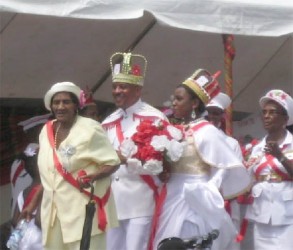One of the very interesting traditional festivals that still exist in the Caribbean has its grand performance at the end of August each year. This is the La Rose (Lawoz) of St Lucia, a folk performance that belongs to a number of different theatrical traditions and social phenomena and is practised in many villages in the island. A significant factor that is relatively little known is that Lawoz has existed for many generations in Guyana as part of a linguistic, cultural and family connection with St Lucia.
La Rose is the Festival of the Rose, and Lawoz is the name used by its French Creole or Patois speaking practitioners. This name may be literally translated as ‘the rose’ from the patois or Kweol (Creole language). This is the first language of most St Lucians who perpetuate the festival, and Kweol is one of the names they use for the language. (Kweol dictionaries have been published.)
This rose festival may be classified in a number of ways in folk traditions. It is a calendar festival – meaning it is held at a particular date each year, and in most cases, this date has some significance. It is a theatrical and a performance tradition because it is practised through the performance of things using masquing, dance, mime, play-acting and costume. It is street theatre because on the grand day of the festival the performance takes place on the streets. The La Rose belongs to the masquerade (maskarade) tradition since this main performance is a street procession of costumed characters including masquing, theatrics and dramatizations within the street parade.
 Additionally, it is a satirical festival in a tradition of rivalry for reasons explained below. There is a season – La Rose culminates with the street parade on August 31, but the events leading up to this date start long before and include many social activities.
Additionally, it is a satirical festival in a tradition of rivalry for reasons explained below. There is a season – La Rose culminates with the street parade on August 31, but the events leading up to this date start long before and include many social activities.
The name comes from the fact that the celebrants belong to a ‘society’ whose symbol and object of near-worship is the rose flower. This may be called the society of the rose. In this cultural form there are many things that the people do because of their membership of this ‘society’. One of the social associations is the linking of the festival with emancipation because of its proximity to celebrations of emancipation in August, and the origins of La Rose.
These origins are found in myth (or legend) but held by the folk to be history. The story is set in Lima, Peru, and is a tale of miracle, liberation from servitude, and reward for resistance and good deeds. The story goes that a girl named Rose worked in the great house on a plantation. Her relatives and friends working in the fields and elsewhere on the property were quite badly treated often without enough to eat. So Rose was in the habit of taking loaves of bread from the kitchen, hiding them in her apron, and taking them at night out to her relatives. She was soon regarded with suspicion and watched. One evening while she was carrying the bread out she was stopped by the guards and ordered to open her apron. She had no choice but to comply; as she did so a miracle was created – instead of loaves, bunches of roses fell from her apron. This saved her and was divine reward for her acts of resistance.

She became Santa Rosa de Lima (Saint Rose of Lima), sanctified and celebrated by the folk in St Lucia. A possible bridge between the island and the original setting of the story is the strong Roman Catholicism. The island celebrants adopt both the sanctified girl’s name and the rose flower immortalised in the miracle, as their symbol.
Many St Lucians align themselves with this society of the rose. It is of interest how it is a mythical and seemingly playful folk pretence, but seriously ingrained in social practice. It is more than a performance because it is a cultural form timed with annual social activities. The people of the community are involved in what is a virtual social custom encompassing family and an organised institution.
At the appropriate time each year various communities begin the La Rose activities. A family is selected; the heads of that family are anointed king and queen and their children become princes and/or princesses.
They hold those positions throughout the ‘season’ and the others pay homage to them. During this time the community holds séances, which are social events at which songs are rehearsed and performed with dance.
The king and queen preside over these sessions and the people pay homage to them, sometimes in formal speeches. One of the social values and engagements of these séances is that they are also used as fund-raisers.
Money is collected which is used to help finance the grand performance on August 31. They are also used to rehearse the songs, some of which are in praise of the rose while others are aimed at their rivals.
The culminating street masquerade is a theatre of social comment and satire. This deepens La Rose’s existence as social interaction. Of course, the royal family reigns, elaborately costumed at the head of the parade while many others assume different roles. There are magistrates, policemen, nurses, and other social functionaries, including ‘doctor plays’ known to masquerades, in which persons feign illness and need to be revived. Similarly, others play thieves and miscreants to be arrested by the police and brought before the magistrate. All these performances are part of this colourful parade, which also includes the songs.
There are two kinds of songs performed, the first are composed in praise of the rose flower, while the second is mepuis – songs of ridicule and satire aimed at the rivals of the rose society. This is where the La Rose is a festival of satire and rivalry, which are common features of Caribbean folk performance.
There are really two rival bands in St Lucian society. The second is Lamagrit – the society of the Marguerite flower, which stand in opposition to Lawoz. They hurl insults at each other and pretend to be enemies. They play-act a perennial feud, ridiculing each other in song. In other forms of masquerade in Jamaica, for example, similar kinds of rivalry used to get seriously violent. But this clash between the Lawoz and Lamagrit continues the longstanding tradition of rivalry and satire in folk theatre.
There are different explanations provided to explain how different people come to join the rose or the marguerite. One version is that families take it very seriously. Each new baby coming into the family is handed a rose flower or a marguerite at some time and observed. Which society the baby will eventually join will be determined by favourable or hostile treatment of one or the other. Another has to do with the colours – red for the rose and blue for the marguerite. There are other stories, but the least far-fetched involve persons arbitrarily gravitating to where their families or friends might be.
The La Rose tradition is known in Guyana and for several years was practised in Mahdia. There is a strong community of French Patois (Kweol) speakers in Mahdia, who have been known to continue St Lucian cultural traditions. They belong to a community of St Lucians and Guyanese descendants of St Lucians. Starting in the 1930s, many St Lucians travelled to British Guiana to work in the goldfields. They joined mining companies and several stayed on in Mahdia. This created a strong community in which La Rose was practised up to recently. The impression given by residents there is that it has not faded away, but no festival was held in 2011 because of a problem with sponsorship. Mahdia was struck by a large fire that affected businesses which usually provided funds.
The Guyana-St Lucia connection was remarkably vibrant. The language was strong and widely spoken. St Lucians and their descendants had settled in other occupations in the town after leaving the mining industry. The patois speaking people there, however, were affectionately called ‘pallawallah’ by other Guyanese because of the language to which they gave the same name.
The power of these traditions wane as the years progress. They become subject to cultural change, but much more to diffusion and acculturation. The La Rose, too, has always seemed considerably larger and more popular than La Marguerite in St Lucia, and it was certainly more one-sided in Mahdia. Playwright Roderick Walcott, twin brother of Derek Walcott has written plays based on the tradition. The first is the more prominent Banjo Man, also called Chanson La Rose because of its subject. The lesser known work is titled Chanson Marguerite.
Researchers have taken an interest in Mahdia as a language community. Ian Robertson did a study based on fieldwork done by UG students, and more recently by Anthea Octave of the UWI.








